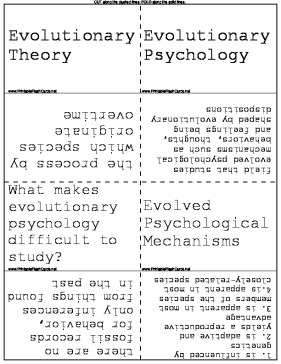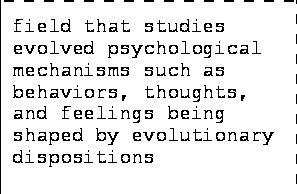

Biologists and anthropologists can study sexual behavior and systems of reproduction with these science flash cards.
There are 32 flash cards in this set (8 pages to print.)
To use:
1. Print out the cards.
2. Cut along the dashed lines.
3. Fold along the solid lines.
Sample flash cards in this set:




| Questions | Answers |
|---|---|
| Evolutionary Theory | the process by which species originate overtime |
| Evolutionary Psychology | field that studies evolved psychological mechanisms such as behaviors, thoughts, and feelings being shaped by evolutionary dispositions |
| What makes evolutionary psychology difficult to study? | there are no fossil records for behavior, only inferences from things found in the past |
| Evolved Psychological Mechanisms | 1. is influenced by genetics 2. is adaptive and yields a reproductive advantage 3. is apparent in most members of the species 4.is apparent in most closely-related species |
| Perspectives of Study | 1. Proximate causation: tells us the how 2. Ultimate causation: tells us the why (evolutionary psych always is passing on genes) |
| What is the proximate and ultimate causation's of falling in love? | Proximate: for social psych it is passion, for biopsych it is hormones, dopamine, and breakup is similar to withdrawel (physical pain) 2. Ultimate is babies are needy so bi parental care is needed and love creates that para-bond |
| Four Processes of Evolution | 1. Selection: certain members of a species pass on more genes than other members of the species, changing gene frequency 2. Gene flow (migration): exchange in genes from one population to another, an example being warfare and migrations (black irish) 3. Genetic Drift: random sampling from another/larger gene pool 4. Mutation: random change in genetic code which is the only process involving new genetic information |
| Misconceptions of Evolution | 1. evolution is a conscious, deliberate process 2. evolution creates advanced or better organisms 3. human behavior is genetically determined 4. if behavior is driven by evolution, then we cannot change it 5. survival of the fittest describes the best survive and outlive others |
| Fitness (selection) | if you have passed on your genes, you are fit |
| Direct fitness (selection) | You reproduce |
| Indirect fitness (selection) | Your family reproduces |
| Methods of Testing Evolutionary Hypotheses | 1. comparing against species (for humans, primarily primates) 2. comparing individuals within a species 3. sex differences such as male v. female strategies 4. consider same individuals in respect to context (environmental influence) 5.experimental methods which include using manipulations to see reactions |
| Sources of Data for Evolutionary Data | 1. archaeological records like fossils and bones 2. data from hunter gatherer societies because it is the closest to how we lived in the past 3. naturalistic observations of how people react (beer goggle) 4. life history data and public records such as marriage and divorce rates, births/deaths, crime rates, and place of residency 5. human products such as fast food restaurants and pornography |
| What happens when with divorce rates every 4 years? | they go up because not as much bi parental care is needed after 4 years old |
| Why do we want to live by the water? | we used to be aquatic in our ancestral past |
| What is the Biogenetic Law? | A theory proposed in 1866 by German zoologist Ernst Haeckel stating our prenatal period mimics our ancestral past (we all start the same). "ontonogy recapulates phylogeny" |
| Examples of the Biogenetic Law | 1. Primitive gill slits during embryological development 2. Embryos covered with hair just like chimps 3. Polymastia 4. Gamete Reproduction is so large because we used to go through external fertilization when we were aquatic 5. Behavioral traits such as crawling (quadrapedel) and swimming (bouyant) 6. Grasping reflex and Babinski reflex (spread toes, trigger is hair) 7. Vestigial traits such as nictating membrane and body hair 8. Arm swing with opposing foot in motion with walking 9. Some facial muscles remain active such as raising eyebrows and grinning 10. Existence of toe and finger prints because of friction needed for tree and hair gripping |
| Brain Intelligence and Evolution | 1. Cephalization: emergence of a distinguishable head 2. Encephalization: emergence of brain in head 3. Corticalization: cortex takes over main part of brain |
| What makes the head different? | Most of the senses are located in the head because they are localized by the brain |
| What parts of the brain developed with encephalization? | 1. Language communication development 2. Hind brain with primitive functions 3. Medulla: vital functions, part of HB 4. Cerebellum: muscle movement (part of HB) 5. Midbrain controls emotions 6. Forebrain contains the cortex which facilitates higher cognition |
| What is one factor towards humans having intelligence? | Humans and dolphins both have the cortex as the largest structure in comparison to the brain mass ratio |
| Asexual Reproduction | The offspring are identical copies of the parents with the exception of whatever mutations occur |
| Advantages of asexual reproduction | -100% of genes are passed on -No problem of searching for a mate |
| Disadvantages of asexual reproduction | -No varience |
| Sexual Reproduction | offspring are byproduct of genes from two parents |
| Advantages of sexual reproduction | -Genetic diversity which acts as a defense against parasite/predator problems and accounts for different survival requirements and inhabit broader range of niches (living by equator = slender for smaller surface area and darker for protection) |
| Disadvantages of sexual reproduction | -only 50% of genes passed on -mating effort needed |
| Sexual selection | the process with mate choice and competition as opposed to natural selection |
| Four Types of sexual selection | 1. male mate choice 2. female mate choice 3. male-male competition 4. female-female competition |
| Three Fundamental Biological Differences between the Sexes | 1. Genetic assurance: is the baby yours? 2. Parental investment: females minimal investment is far more than males 3. Reproductive potential: # gametes, reproduction lifespan, # possible offspring |
| Types of Selection | 1. R-selection: species have potential to produce a lot of offspring 2. k-selection: few offspring and very needy Both types of selection yield the same amount of offspring statistically |
| Which type of selection pertain to which gender? | Males are precocial which is r-selection. Females are quality which is k-selection |